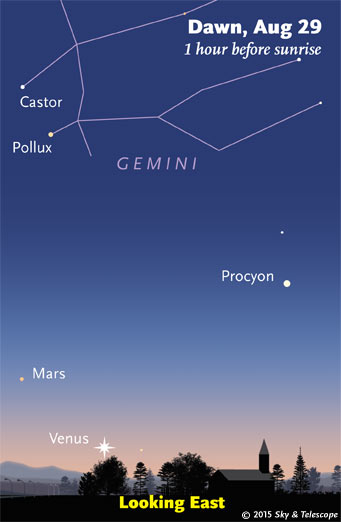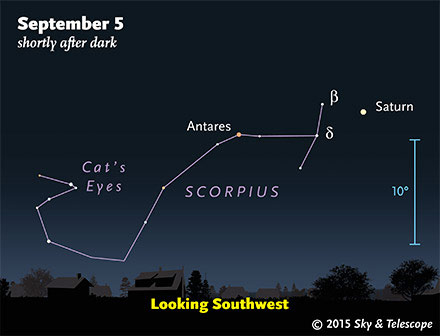
Friday, August 28
• By the end of twilight, Cassiopeia rises as high in the northeast as the Big Dipper sinks in the northwest. Midway between them, and a little higher, you'll find Polaris, around which the whole sky rotates day and night.
• Have you spotted Mars and Venus yet? They're coming up into the dawn, beginning long and exciting apparitions. Look low in the east. They're easier every day.
Saturday, August 29
• Full Moon (exact at 2:35 p.m. Eastern Daylight Time). Well to the Moon's left or upper left this evening, look for the Great Square of Pegasus balancing on one corner. It's a bit larger than your fist at arm's length.
Sunday, August 30
• Can you see that the Moon is no longer quite full now? And, it has moved closer to the Great Square of Pegasus (to its upper left).
Monday, August 31
• The two brightest stars of summer are Vega, overhead right after dark, and Arcturus, declining ever lower in the west. The name Vega comes from an ancient Arabic phrase for "the diving eagle." Arcturus is from ancient Greek for "bear watcher" or "bear guardian," referring to the way it follows Ursa Major, the Great Bear, around the sky.
• The brightest part of the Bear, the Big Dipper, is dipping down well to the right of Arcturus, in the northwest.
• Neptune is at opposition.
Tuesday, September 1
• Vega stands nearly overhead at nightfall; Arcturus is down in the west. Look a third of the way from Vega to Arcturus for the dim Keystone of Hercules. Two thirds of the way is the semicircle of Corona Borealis, the Northern Crown, with its one modestly bright gem, Alphecca.
Wednesday, September 2
• Vega passes your zenith if you live in the world's mid-northern latitudes. Vega goes right through your zenith at nightfall if you're at latitude 39° north: near Baltimore, Kansas City, Lake Tahoe, Sendai, Beijing, Athens, Lisbon.
Thursday, September 3
• Have you ever heard of Riddle's Trapezium? Archenal 1? They're together in the same telescopic field of view in Serpens Cauda, as Sue French tells in her Deep-Sky Wonders column in the September Sky & Telescope, page 55.
Friday, September 4
• The last-quarter Moon rises around 11 or midnight tonight very close to Aldebaran, depending on your location. The Moon occults Aldebaran soon after rising for parts of eastern North America, and in Saturday's dawn or daylight for Europe and western Asia. See the article with map in the September Sky & Telescope, page 51.
• The Moon is exactly last quarter at 5:54 a.m. Saturday morning Eastern Daylight Time.
Saturday, September 5
• The wide W pattern of Cassiopeia is tilting up in the northeast after dark. Below the W's bottom segment, by a little farther than the segment's length, look for an enhanced spot of the Milky Way's glow (if you have a fairly dark sky). Binoculars will show this to be the Perseus Double Cluster, even through a fair amount of light pollution.
__________________________
Want to become a better astronomer? Learn your way around the constellations. They're the key to locating everything fainter and deeper to hunt with binoculars or a telescope.
This is an outdoor nature hobby. For an easy-to-use constellation guide covering the whole evening sky, use the big monthly map in the center of each issue of Sky & Telescope, the essential guide to astronomy.

Once you get a telescope, to put it to good use you'll need a detailed, large-scale sky atlas (set of charts). The standards are the little Pocket Sky Atlas, which shows stars to magnitude 7.6; the larger and deeper Sky Atlas 2000.0 (stars to magnitude 8.5); and once you know your way around, the even larger Uranometria 2000.0 (stars to magnitude 9.75). And read how to use sky charts with a telescope.
You'll also want a good deep-sky guidebook, such as Sue French's Deep-Sky Wonders collection (which includes its own charts), Sky Atlas 2000.0 Companion by Strong and Sinnott, the bigger Night Sky Observer's Guide by Kepple and Sanner, or the beloved if dated Burnham's Celestial Handbook.
Can a computerized telescope replace charts? Not for beginners, I don't think, and not on mounts and tripods that are less than top-quality mechanically (meaning heavy and expensive). As Terence Dickinson and Alan Dyer say in their Backyard Astronomer's Guide, "A full appreciation of the universe cannot come without developing the skills to find things in the sky and understanding how the sky works. This knowledge comes only by spending time under the stars with star maps in hand."
This Week's Planet Roundup

Mercury (magnitude +0.1) lurks very low in bright twilight almost due west. About 20 minutes after sunset, use binoculars or a wide-field telescope to scan for it just above the horizon. (Don't confuse it with twinkly Spica, far to its upper left.)
Venus (about magnitude –4.5) gets higher and brighter every morning. Look for it low in the east during dawn. Venus moves rapidly higher day by day. It a telescope it's a beautiful thin crescent, especially if you follow it rising up into thinner air after sunrise.
Mars, 300 times fainter (magnitude +1.8), is near Venus in the dawn — upper left of it early in the week, directly left of it by week's end. They're roughly a fist-width at arm's length apart.
Jupiter is still hidden deep in the sunrise. But it's on its way.
Saturn (magnitude +0.5, in Libra) shines in the southwest at dusk, to the right of upper Scorpius. Orange Antares, less bright, twinkles 13° to Saturn's left or lower left. Between them is the near-vertical line of three stars marking Scorpius's head.
Uranus (magnitude +5.7, in Pisces) and Neptune (magnitude +7.8, in Aquarius) are up in the east and southeast, respectively, by 10 p.m. Finder charts for Uranus and Neptune.
__________________________
All descriptions that relate to your horizon — including the words up, down, right, and left — are written for the world's mid-northern latitudes. Descriptions that also depend on longitude (mainly Moon positions) are for North America.
Eastern Daylight Time (EDT) is Universal Time (UT, UTC, or GMT) minus 4 hours.
__________________________
“This adventure is made possible by generations of searchers strictly adhering to a simple set of rules. Test ideas by experiments and observations. Build on those ideas that pass the test. Reject the ones that fail. Follow the evidence wherever it leads, and question everything. Accept these terms, and the cosmos is yours.”
— Neil deGrasse Tyson, 2014
 0
0
Comments
You must be logged in to post a comment.